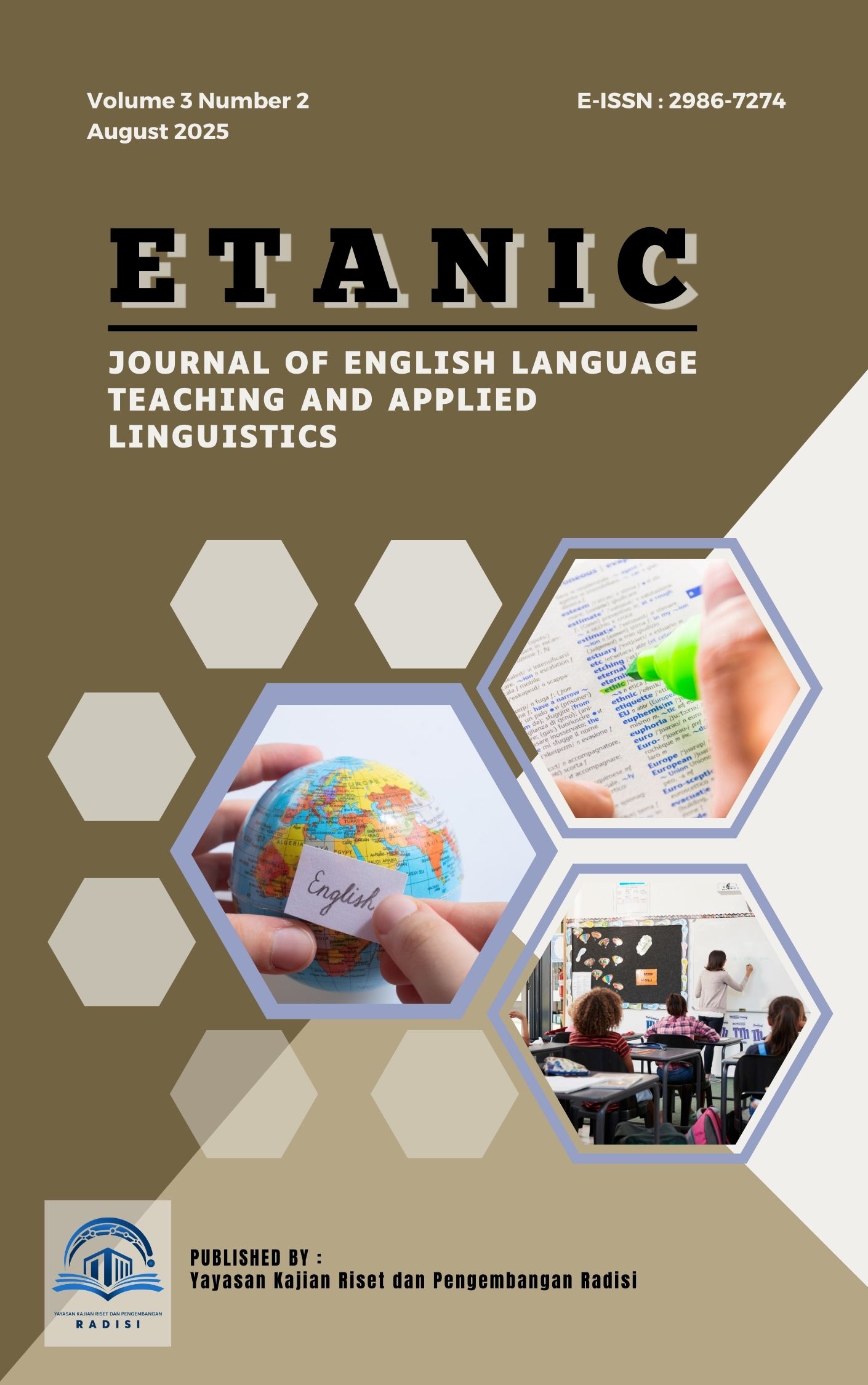Integrative Exploration Of Problem-Based Learning And Artificial Intelligence In Language Education
DOI:
https://doi.org/10.55266/journaletanic.v3i2.574Keywords:
Problem-Based Learning, Artificial Intelligence, Reading Comprehension, Language Education, Literature Review, Instructional DesignAbstract
This integrative literature review examines the potential synergy between Problem-Based Learning (PBL) and Artificial Intelligence (AI) in improving university students’ reading comprehension within language education. Based on 276 selected articles, the analysis highlights three key themes: PBL's role in fostering critical reading, AI's function in personalizing language learning, and the importance of instructional design in linking both approaches.
Findings show that while PBL and AI each contribute meaningfully, their integration in language education is rare and lacks systematic application. Major gaps include the absence of tested instructional models, limited evaluation tools, and a shortage of empirical studies in Southeast Asia. The study recommends developing theory-based integrative instructional models and conducting localized research to support effective implementation.
References
Bevilacqua, M., Oketch, K., Qin, R., Stamey, W., Zhang, X., Gan, Y., Yang, K., & Abbasi, A. (2025). When automated assessment meets automated content generation: Examining text quality in the era of gpts. ACM Transactions on Information Systems, 43(2), 1–36.
Branch, R. M. (2009). Instructional Design: The ADDIE Approach. Springer US. https://doi.org/10.1007/978-0-387-09506-6
Chen, C. (2023). A quantitative study on the effects of an interactive multimodal application to promote students’ learning motivation and comprehension in studying Tang poetry. Frontiers in Psychology, 14. https://doi.org/10.3389/fpsyg.2023.1189864
Grabe, W., & Stoller, F. L. (2019). Teaching and researching reading. Routledge.
Hmelo-Silver, C. E. (2004). Problem-based learning: What and how do students learn? Educational Psychology Review, 16, 235–266.
Holmes, W., Bialik, M., & Fadel, C. (2019). Artificial intelligence in education promises and implications for teaching and learning. Center for Curriculum Redesign.
Khoiriyah, F., Jennah, M., Wicaksono, M. B., & Susetyo, A. M. (2025). Kajian Literatur: Problem Solving Seorang Pendidik dalam Menghadapi Tantangan Metode Pembelajaran Diskusi di Kelas pada Mata Pelajaran Bahasa Indonesia. Morfologi: Jurnal Ilmu Pendidikan, Bahasa, Sastra Dan Budaya, 3(1), 331–347.
Lin, L. F. (2018). Integrating the Problem-Based Learning Approach Into a Web-Based English Reading Course. Journal of Educational Computing Research, 56(1), 105–133. https://doi.org/10.1177/0735633117705960
Liu, Q., Geng, X., Huang, H., Qin, T., Lu, J., & Jiang, D. (2021). MGRC: An end-to-end multigranularity reading comprehension model for question answering. IEEE Transactions on Neural Networks and Learning Systems, 34(5), 2594–2605.
Mardini G, I. D., Quintero M, C. G., Viloria N, C. A., Percybrooks B, W. S., Robles N, H. S., & Villalba R, K. (2024). A deep-learning-based grading system (ASAG) for reading comprehension assessment by using aphorisms as open-answer-questions. Education and Information Technologies, 29(4), 4565–4590.
Mareti, J. W., & Hadiyanti, A. H. D. (2021). Model problem based learning untuk meningkatkan kemampuan berpikir kritis dan hasil belajar IPA siswa. Jurnal Elementaria Edukasia, 4(1), 31–41.
Mukhlis, M., Asnawi, A., Afdal, A., & Junaidi, F. (2024). Kemampuan Literasi Membaca Siswa di SMK Pusat Keunggulan Kota Pekanbaru. JP-BSI (Jurnal Pendidikan Bahasa Dan Sastra Indonesia), 9(1), 1–7.
Rathje, S., Mirea, D.-M., Sucholutsky, I., Marjieh, R., Robertson, C. E., & Van Bavel, J. J. (2024). GPT is an effective tool for multilingual psychological text analysis. Proceedings of the National Academy of Sciences, 121(34), e2308950121.
Reigeluth, C. M. (2016). Designing technology for the learner-centered paradigm of education. In Instructional-Design Theories and Models, Volume IV (pp. 287–316). Routledge.
Savery, J. R. (2015). Overview of problem-based learning: Definitions and distinctions. Essential Readings in Problem-Based Learning: Exploring and Extending the Legacy of Howard S. Barrows, 9(2), 5–15.
Severino, L. (2021). Using a design thinking approach for an asynchronous learning platform during COVID-19. Iafor Journal of Education, 9(2), 145–162. https://doi.org/10.22492/ije.9.2.09
Zou, W. (2024). A Multi-task Shared Cascade Learning for Aspect Sentiment Triplet Extraction Using BERT-MRC. Cognitive Computation, 16(4), 1554–1571. https://doi.org/10.1007/s12559-024-10247-7
Downloads
Published
How to Cite
Issue
Section
License
Copyright (c) 2025 Yuswin Harputra, Yulia Rizki Ramadhani

This work is licensed under a Creative Commons Attribution-ShareAlike 4.0 International License.





